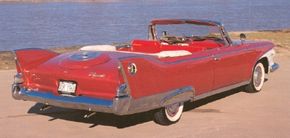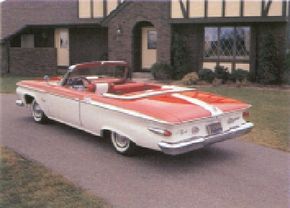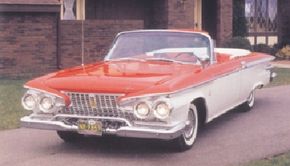The 1960-1961 Plymouth Fury was an attempt by Plymouth to capitalize on the success of earlier, limited production Fury models.
Advertisement
Through 1959, the Plymouth Fury had been a limited production performance Plymouth. By 1960, the name was too good to squander on such a small market, so "Fury" replaced "Belvedere" as the top-of-the-line model designation, with a four-door sedan and four-door hardtop joining the previous two-door hardtop and convertible. All, of course, used Plymouth's new unibody construction.
The change made good business sense. The styling of the 1960 Plymouth Fury didn't. It had been conceived in 1957, when tailfins were all the rage, and fin-wise it was as good as the best of them. The problem was that the public had grown tired of tailfins by 1960. Worse, Plymouth sales had been skidding since the 1958 recession. Thus, while Ford and Chevrolet increased their combined production by about a quarter-million units in 1960, Plymouth barely maintained its 1959 volume level.
Then on the 1961 Plymouth Fury, the fins vanished entirely, replaced by a rounded shape with a swoopy front end that Motor Trend once retrospectively compared with "a generation of Japanese sci-fi monsters." The public remained unimpressed, and was now also confused: Plymouth sales dropped by 100,000 and Rambler replaced Plymouth as the number three best-seller.
None of which should suggest that these 1960-1961 Plymouth Furys were bad cars. Compared to their arch rivals, they were as good in most ways and superior in some. Every road tester agreed that they easily outhandled the Chevrolet Impala and Ford Galaxie, their counterpart top-of-the-line competitors, thanks to their torsion bar front suspension. Plymouth's TorqueFlite automatic was better than Chevrolet's Turboglide or Ford's Cruise-O-Matic. Fury's unit body was tighter than the separate body/frame rigs of the opposition, and so on.
The Fury also had two exclusive options: swivel seats that pivoted when the front doors were opened, and the RCA Victor "Highway Hi-Fi" record player. But it was styling that sold cars in 1960, and styling, in the public's judgment, was not the Fury's strong point.
Go to the next page to learn more about the design of the 1960-1961 Plymouth Fury.
For more information on cars, see:
- Classic Cars
- Muscle Cars
- Sports Cars
- Consumer Guide New Car Search
- Consumer Guide Used Car Search
Advertisement


